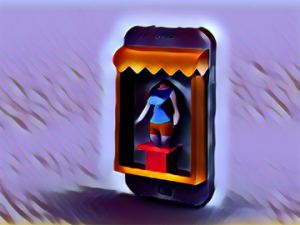Brand storytelling is the art of creating a compelling narrative around your brand that resonates with your target audience.
It is a powerful marketing strategy that helps to create an emotional connection between your brand and your customers, build brand loyalty, and generate brand awareness.
In this definitive guide, we will explore the key elements of powerful brand storytelling, provide a step-by-step guide on how to map out your brand story and showcase various examples of successful brand storytelling.
Why is brand storytelling important?
Brand storytelling is important because it enables brands to communicate their values, purpose, and mission in a way that engages and resonates with their target audience.
A well-crafted brand story helps to humanize your brand, creating a connection between your brand and your customers at an emotional level.

The more your audience feels connected to your brand, the more brand loyalty, increased customer retention, and the ability to attract new customers.
The Elements of Powerful Brand Storytelling
A compelling brand story comprises several key elements that come together to create a narrative that resonates with your audience. These elements include:
- Hero’s journey: A well-crafted brand story should take your audience on a journey that resonates with them emotionally. The journey should involve challenges, obstacles, and a satisfying resolution that makes your customers feel connected to your brand.
- Brand purpose: Your brand purpose defines why your brand exists beyond making a profit. It should communicate your brand’s values, beliefs, and the impact you want to make in the world.
- Brand values: Your brand values are the principles that guide your brand’s behavior, decisions, and actions. They should be evident in your brand’s messaging and should align with your target audience’s values.
- Brand personality: Your brand personality is the character or tone that your brand communicates to your audience. It should reflect your brand’s values and be consistent across all your brand’s messaging and marketing channels.
- Company history: Your company’s history helps to humanize your brand and creates a sense of authenticity that resonates with your audience.
Map Out Your Brand Story in 7 Steps
So now that you understand what a brand story consists of, reflect on each one of these types to see which fits best for your company:
- Mission-focused brand storytelling: Define your brand’s mission and the impact you want to make in the world.
- Audience-centered brand storytelling: Know your audience and create a story that resonates with them emotionally.
- Data-driven brand storytelling: Use data to create a story that resonates with your target audience’s needs and interests.
- Employee-focused brand storytelling: Make your employees part of your brand’s story by highlighting their role in your brand’s success.
- Product or service-based brand storytelling: Use your product or service as a vehicle to tell your brand’s story.
- Define your brand story and its purpose: Define your brand’s story and its purpose by answering questions such as “What inspired your brand’s creation?” and “What problems does your brand solve?”
- Write down your brand story: Write down your brand story, including the key elements we discussed, in a way that resonates with your target audience.
Mission-Focused Brand Storytelling
Mission-driven storytelling is a strategy that involves using your brand’s mission as the foundation of your brand’s story.
The goal is to create a narrative that showcases how your brand’s mission drives everything you do, and how it makes a positive impact in the world.

To implement a mission-driven storytelling strategy, a company can follow these steps:
- Define your brand’s mission: Define your brand’s purpose, values, and goals, and how they align with your target audience’s needs and interests.
- Use storytelling techniques: Use storytelling techniques, such as the hero’s journey, to create a narrative that showcases how your brand’s mission drives everything you do.
- Create engaging content: Create engaging content, such as videos, photos, and educational content, that showcases how your brand’s mission makes a positive impact in the world.
- Measure and adjust: Use data to measure the success of your mission-driven storytelling strategy and adjust it accordingly.
So what are some of the benefits:
- Increase brand authenticity: Using your brand’s mission as the foundation of your brand’s story can add authenticity and credibility to your brand’s narrative.
- Build brand loyalty: By showcasing how your brand’s mission makes a positive impact in the world, you can build brand loyalty and attract customers who share your values.
- Attract talent: Highlighting your brand’s mission can attract talent that aligns with your brand’s purpose and values.
- Create an emotional connection: Using storytelling techniques can create an emotional connection between your brand’s mission and your target audience, making them more likely to buy.
Audience-centered brand storytelling
Audience-centered brand storytelling is a strategy that focuses on creating a brand story that resonates with your target audience.
The goal is to create a story that speaks to your audience’s needs, interests, and emotions, making them feel connected to your brand on a deeper level.
By doing so, you can increase brand loyalty, attract new customers, and generate brand awareness.
To use audience-centered brand storytelling, you need to understand your target audience’s needs and interests.
This involves conducting market research to gather data about your target audience, such as their demographics, interests, and pain points.
Once you have this information, you can create a story that speaks to their needs and emotions.
To create an audience-centered brand story, follow these steps:
- Define your target audience: Identify who your ideal customers are, their interests, values, and pain points.
- Determine your brand’s unique value proposition: Define what makes your brand unique and how it solves your target audience’s problems.
- Craft your brand’s message: Develop messaging that communicates your brand’s unique value proposition in a way that resonates with your target audience.
- Use storytelling techniques: Use storytelling techniques such as the hero’s journey to create a narrative that speaks to your target audience’s needs and emotions.
- Create content that engages your target audience: Use various marketing channels, such as social media, email, and educational content, to engage your target audience and build an emotional connection with them.
- Measure and adjust: Use data to measure the success of your audience-centered brand storytelling and adjust your strategy accordingly.
Data-Driven Brand storytelling
Data-driven brand storytelling is a strategy that involves using data to inform your brand’s story.
The goal is to create a narrative that is backed by data and resonates with your target audience’s needs and interests.
To implement a data-driven brand storytelling strategy, a company can follow these steps:
- Identify the data you need: Identify the data that is relevant to your brand’s story, such as customer feedback, industry trends, and market research.
- Analyze the data: Analyze the data to identify patterns, trends, and insights that can inform your brand’s story.
- Craft your brand’s story: Use the data to craft a story that resonates with your target audience’s needs and interests, and is backed by data.
- Create engaging content: Create engaging content, such as infographics, videos, and educational content, that showcases the data and tells your brand’s story in an engaging way.
- Measure and adjust: Use data to measure the success of your data-driven brand storytelling strategy and adjust it accordingly.
Here are a few of the benefits:
- Increase credibility: Using data to inform your brand’s story can increase your brand’s credibility and make it more trustworthy to your target audience.
- Communicate your brand’s value: Using data to showcase your brand’s value proposition can communicate its unique value to your target audience.
- Make informed decisions: Using data to inform your brand’s story can help you make informed decisions about your marketing strategy and product development.
- Build brand loyalty: By crafting a story that resonates with your target audience’s needs and interests, you can build brand loyalty and attract customers who share your values.
Employee-focused brand storytelling
Audience-centered brand storytelling is a strategy that focuses on creating a brand story that resonates with your target audience.
The goal is to create a story that speaks to your audience’s needs, interests, and emotions, making them feel connected to your brand on a deeper level.
This can increase brand loyalty, attract new customers, and generate brand awareness.
To use audience-centered brand storytelling, you need to understand your target audience’s needs and interests.

This involves conducting market research to gather data about your target audience, such as their demographics, interests, and pain points.
Once you have this information, you can create a story that speaks to their needs and emotions.
To create an audience-centered brand story, follow these steps:
- Define your target audience: Identify who your ideal customers are, their interests, values, and pain points.
- Determine your brand’s unique value proposition: Define what makes your brand unique and how it solves your target audience’s problems.
- Craft your brand’s message: Develop messaging that communicates your brand’s unique value proposition in a way that resonates with your target audience.
- Use storytelling techniques: Use storytelling techniques such as the hero’s journey to create a narrative that speaks to your target audience’s needs and emotions.
- Create content that engages your target audience: Use various marketing channels, such as social media, email, and educational content, to engage your target audience and build an emotional connection with them.
- Measure and adjust: Use data to measure the success of your audience-centered brand storytelling and adjust your strategy accordingly.
Product or service-based brand storytelling
Using products or services as a vehicle for brand storytelling is a strategy that involves using your product or service to tell your brand’s story.
The goal is to create a narrative that showcases how your product or service solves your own target market or audience’s problems, aligns with your brand’s values, and makes a positive impact in the world.
To use product or service-based brand storytelling, a company can follow these steps:
- Define your target audience: Identify who your ideal customers are and their pain points.
- Define your brand’s unique value proposition: Define what makes your product or service unique and how it solves your target audience’s problems.
- Use storytelling techniques: Use storytelling techniques, such as the hero’s journey, to create a narrative that showcases your product or service’s value and impact.
- Create engaging content: Create engaging content, such as videos, photos, and educational content, that showcases how your product or service solves your target audience’s problems and aligns with your brand’s values.
- Measure and adjust: Use data to measure the success of your product or service-based brand storytelling strategy and adjust it accordingly.
Now let’s review some of the benefits that come with a product or service-based brand story:
- Increase brand awareness: Using your product or service as a vehicle for brand storytelling can increase brand awareness and attract new customers.
- Build brand loyalty: Creating a narrative that aligns with your brand’s values and purpose can build brand loyalty and attract customers who share your values.
- Communicate the value of your product or service: By showcasing how your product or service solves your target audience’s problems, you can communicate its value and differentiate it from competitors.
- Create an emotional connection: Using storytelling techniques can create an emotional connection between your product or service and your target audience, making them more likely to buy.
Define your brand story and its purpose
Defining your brand story and its purpose is a crucial step in creating a compelling brand narrative.
Your brand story is the narrative that describes who you are, what you do, and why you do it.
Defining your brand story and its purpose can help you communicate your brand’s values, differentiate yourself from competitors, and build a connection with your target audience.
To define your brand story and its purpose, a company can follow these steps:
- Identify your brand’s values: Identify the core values that your brand stands for, such as honesty, innovation, or social responsibility.
- Define your brand’s purpose: Define why your brand exists and how it makes a positive impact in the world.
- Craft your brand’s story: Use storytelling techniques, such as the hero’s journey or the three-act structure, to craft a narrative that aligns with your brand’s values and purpose.
- Communicate your brand’s story: Use various marketing channels, such as social media, website, and other marketing materials, to communicate your brand’s story to your target audience.
Here are just some of the benefits a company can achieve:
- Differentiate from competitors: Defining your brand’s values and purpose can differentiate your brand from competitors who may offer similar products or services.
- Build brand identity: Crafting a compelling brand story can help build a strong brand identity that resonates with your target audience.
- Create an emotional connection: Using storytelling techniques to communicate your brand’s story can create an emotional connection between your brand and your target audience.
- Attract talent: Defining your brand’s values and purpose can attract talent that aligns with your brand’s values and purpose.
Brand Story Examples
To help you understand how various brands have successfully used storytelling in their marketing strategy, let’s look at some brand storytelling examples:
Nike’s “Just Do It” campaign is a great example of a brand that has successfully used storytelling to build brand loyalty.
The campaign’s message of empowerment and the journey of the athletes featured in the campaign resonated with Nike’s target audience, making them feel connected to the brand.
Coca-Cola’s “Share a Coke” campaign is another great example of brand storytelling. The campaign’s message of sharing a Coke with friends and family fostered a sense of community and connection, which resonated with Coca-Cola’s target audience.
By personalizing their product with customers’ names, Coca-Cola created an emotional connection with their customers, making them feel valued and seen.
Another example is Patagonia’s “The New Localism” campaign, which highlighted the importance of local communities and sustainability.
The campaign’s message aligned with Patagonia’s brand purpose and values, making it relatable and resonant with its target audience.
Educational content and audience engagement are also important elements of brand storytelling.
For instance, HubSpot, a marketing and sales software company, provides educational content to help businesses grow.
Since Hubspot focuses on providing valuable information to its audience, they’ve established itself as a thought leader in the industry and creates a sense of trust and authority with its target audience.
These examples showcase how brand storytelling can be used to make great stories, create emotional connections with your target audience and build brand loyalty.
Write Your Brand Story
Now it’s your turn. Here is a quick getting started template that can help you write your own brand story.
- Start with a hook: Start your brand story with a hook that grabs the attention of your target audience.
- Introduce your brand: Introduce your brand and what it does.
- Explain your brand’s values and purpose: Explain the values and purpose that drive your brand and how they align with your target audience’s needs and interests.
- Highlight your brand’s unique selling proposition: Highlight what sets your brand apart from competitors and how it solves your target audience’s problems.
- Use storytelling techniques: Use storytelling techniques, such as the hero’s journey, to create a narrative that showcases your brand’s journey and the impact it makes in the world.
- Show the results: Showcase the results of your brand’s efforts and how they make a positive impact in the world.
- End with a call-to-action: End your brand story with a call-to-action that encourages your target audience to take action, such as buying your product or service, signing up for your newsletter, or following you on social media.
Your brand story will continue to evolve over time as your company’s mission statement changes. So support it and allow your brand messaging to grow with you.
To Recap…
A strong brand story is an essential part of any marketing strategy.
It enables you to communicate your brand’s purpose, values, and mission in a way that resonates with your audience.
By creating compelling customer stories, that speak to your target audience’s needs and interests, you can foster an emotional connection with your customers, increase brand loyalty, and attract new customers.
To create a great story that resonates with your target audience, focus on the key elements of powerful brand storytelling, such as the hero’s journey, brand purpose, brand values, brand personality, and company history.
Use the 7-step guide we provided to map out your brand story, and don’t forget to showcase examples of successful brand storytelling to inspire your own content.
By following these guidelines, you can create a strong brand story that makes your potential customers feel connected to your brand and inspires them to buy in to your marketing messages, without strings attached.
Remember to focus on your target audience and create content that resonates with their needs and interests.
Use your brand’s voice and messaging consistently across all your marketing channels, including social media and other marketing materials.
By doing so, you can create a satisfying resolution to your brand’s origin story that leaves your customers feeling happy and connected.
Ready to take your business to the next level? Join zindolabs.com and gain access to a community of like-minded entrepreneurs, expert advice, and proven strategies to help you grow your business. Sign up today and start building your dream business!









